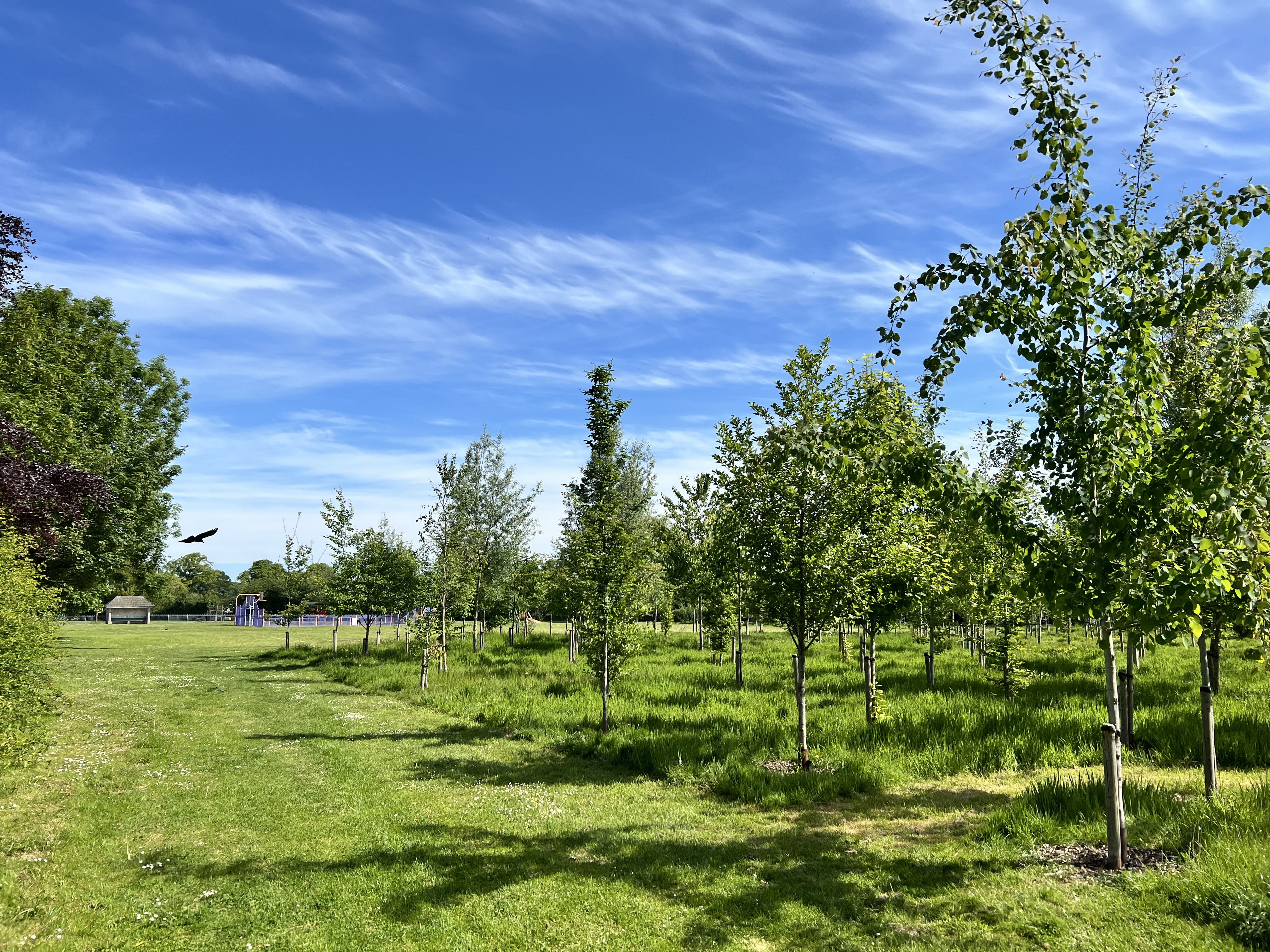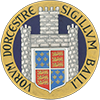Trees in the Town Council's open spaces
We have trees in most of our parks, gardens, open spaces, playing fields and cemeteries.
The plantings take many forms. In Borough Gardens, trees are planted singly as a specimen tree or in small groups to create an effect, be it a screen, shrub bed or shelter to provide shade.
At Kings Road, we have created a new area of woodland, planted with native trees selected to produce fruits, flowers and berries to provide food for many animals birds and insects which live naturally in the UK. The trees here are planted closer together and, in time, the woodland will develop a character of its own with deep shade areas, slightly more open zones with woodland flowers and grass walks weaving through the area.
We plant trees where it is sensible to do so, in most areas we will plant with native species, but we will also select decorative species for appropriate locations such as Borough Gardens.
If a tree is felled or dies in an area we manage, we will replace it with two new trees - this may not be at the same location but the tree stock will be increased across Dorchester as a whole.
Veteran trees
The Town Council manages one veteran tree; a fantastic specimen of Acer Campestre (field maple) it is an outstanding example and is located just outside Borough Gardens between West Walks and the old tennis courts.
The Walks
As with most Roman towns in Britain, Dorchester or Durnovaria as it was called by the Romans, was walled, these walls were essential for the safety of the town, with three sides fully covered by walls and ditches, and on the north side protection came from the wall and river.
In the early Eighteenth Century the walls were cleared and The Walks were constructed on them to make a permanent marker of their route, with the southern, western and southern part of the east side of the walks providing clear parameters of the historic town. These Walks were laid out at the same time as the Boulevards in Paris, and give a wonderful environment for strolling and leisurely enjoyment, as well as serving as a living reminder of the original limits of the town. More information about the The Walks and Avenues of Dorchester can be found in a 1916 publication written by Alfred Pope which can be downloaded here.
The Town Council owns the freehold of The Walks but they are also adopted highway which means that Dorset Council is responsible for looking after the trees along them.

Who looks after trees in Dorchester's public spaces
Trees within Dorchester fall broadly into three categories:
- Owned by Dorchester Town Council
- Private ownership, household gardens etc
- Dorset Council ownership (predominantly street trees).
Dorchester Town Council looks after trees in the following locations:
Lubbecke Way: Willows and poplars growing in a riverside setting
Kings Road field: Enjoy Dorchester’s newest wood set in the former open space with rivers running nearby.
Fordington Green: Mature trees set in a traditional local green.
Salisbury Field: A large grass open space bordered by majestic mature Horse Chestnuts in groups and also a traditional avenue along the line of the Roman town wall.
Gallows Hill (Icen Way): Mature trees in a small group.
Sandringham sports fields: Trees of varying ages planted around the perimeter of a sports field.
Gabriel Green (Thomas Hardye Gardens): Newly planted trees on a development green.
Borough Gardens: A highlight for tree lovers, the Gardens contain many mature native and non-native species along with younger specimens of decorative trees and trees traditionally associated with historic gardens.
Riverside Nature Reserve: A small wetland area with willows, ash and poplar of varying ages.
Maumbury Rings: An archaeological highlight! A neolithic henge later modified by the Romans with mature lime trees on its northern boundary.
Weymouth Avenue cricket ground: Trees of varying ages planted around the perimeter of a sports field.
The Great Field: Mainly planted in 2022-23, The Great Field is a new area comprising younger trees planted in both natural settings with wildflowers and in more regularly maintained amenity areas adjoining, semi mature trees mainly horse chestnut and lime surround a sports/amenity field.
Elizabeth Place: A grass open space with a few mature trees.
Fortress Green: A grass open space with semi-mature and newly planted standard trees.
Maiden Castle open space (Castle Park): A grass open space with a row of small hedgerow species.
Frome Terrace: A riverside green with mature horse chestnut and birch with newer plantings of standard size trees.
In addition to the above, we also manage trees in all public play areas in Dorchester and town council owned allotment sites and cemeteries.
What if the tree I’m interested in isn’t at the above locations?
Should you have an issue with street trees then please contact Dorset Council.
Dorset Council will also be able to help with tree issues around planning applications. Tree Preservation Orders and Conservation Area trees and high hedges legislation.
Should you have an issue with neighbours’ trees, you may need to take legal advice, but we would always urge trying to reach an agreement with your neighbour in the first instance.
Why are trees so important in Dorchester?
Your environment
- Trees help to mitigate against climate change by capturing carbon from the atmosphere.
- CO2 is converted to oxygen as part of a trees natural growth processes and in doing this trees ameliorate and refresh the air, especially in very urban built-up locations.
- Trees reduce pollution levels in urban environments. Filtering of the air reduces both gaseous pollution and dust levels; the London Plane is especially significant in reducing airborne dust as well as pollution levels.
- Trees provide shade and help cool the immediate environment around them and in larger plantings more widely too and they also help to generate breeze.
- Trees can help to block traffic noise.
- Finally trees actively increase a sense of wellbeing and reduce stress, this helps people to feel better both physically and mentally.
Nature and wildlife
- Trees providing food, homes and cover to a very wide range of animals, birds, insects and invertebrates, fungi and algae. They provide ‘stepping stones’ for wildlife migrating through Dorchester as part of wildlife corridors or as wildlife havens in a more urban setting.
- Trees provide nesting and roosting opportunities for a range of animals and especially birds and bats.
What do we do to help trees under our management?
We commission two yearly inspections of all trees on Town Council land. inspections assess a trees physiological and structural condition. The Council will always use best arboricultural practice and expects contractors employed to work to BS 3998 2010.
Trees are well evolved living things that predate our presence on the planet by tens of millions of years. As such they have evolved to survive the challenges that gales and foul weather create.
When we will prune a tree...
We will only prune for the removal of dead, diseased, dying, dangerous or crossing material. We will leave pruning in situ in the form of eco piles so wildlife can take advantage of this where it is possible to do so and it does not cause a danger to the public.
Pollarding will not be carried out as a management operation unless no other professional technique is suitable.
Clearance of low branches over paths and roads will be undertaken to allow safe travel below. Trees in gardens and open spaces will be left with a more natural shape where the branches may safely extend down to the ground e.g. open areas of the Great Field.
We will prune trees when they cause physical problems to properties such as where they touch, walls, roofs etc and to avoid structures, such as aerials, tiles or gutters being damaged.
We do not normally prune to allow more light into a property or gardens or to provide a view.

